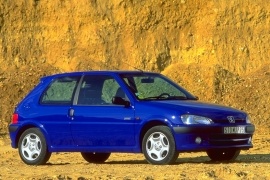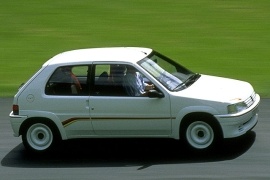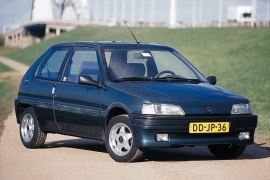PEUGEOT 106 Models/Series Timeline, Specifications & Photos
First production year: 1991
Engines: Gasoline, Diesel
Body style: Hatchback
The little Peugeot 106 was introduced in 1991 as a replacement for both 104 and 205 models. In 1996 it received an important update to extend its lifespan.
The French car-company Peugeot succeeded to build good, reliable cars in the small-segment. It showed interest in the motorsport as well, introducing the 106 GTI as a replacement for the older glory 205 GTI. The 106 was a car that was offered for the economy, for performance, or a middle road between them.
The 1996 model came with a nicer, rounded, exterior look. While at the beginning of the '90s the angular lines were still en vogue, just five years later those were already history. So, the straight-cut front grille was reshaped with rounded corners. The headlights were modified as well. Even the tailgate and the taillights were adjusted according to the new design trend. But it wasn't a rounded car. It was a slightly re-styled one.
Inside, the designers installed a new interior, with more updated features for the audio system. A passenger airbag was introduced to increase safety. It featured power-windows on the options list or fitted as standard depending on the trim level.
For the engine compartment, there were new fuel-injected units that replaced the older, carbureted ones. A new, 1.5-liter diesel engine was introduced as well. For the top version, 1.6-liter GTI, there was a special model with up to 118 hp. And that version was remarkable especially on the brakes, where it could stop faster and shorter than a same-period Porsche 911 Carrera.
The 205 was a legend among European car enthusiasts. So when the French carmaker axed it from the assembly lines, it was very difficult to replace it since everyone would have compared the new model with the older one.
What Peugeot did was to replace it with two vehicles: the 106 and the 206. In addition, the smaller version received a special version named Rallye. It was a homologation-special vehicle built to obtain the FIA credentials to let it go racing.
The 106 Rallye featured a three-door bodywork only. As expected, it shared most of its parts with the regular 106. It sported the same headlights but a different grille. Moreover, the bumper was unique to the Rallye version featuring a broad lower air intake needed to cool the engine. The automaker offered a pair of rectangular fog lamps as an option. But the most distinctive part of this version was the white steel wheels with no caps on them.
Inside, Peugeot striped the regular vehicle from everything that was considered unnecessary. The main idea was to keep the car's weight as low as possible. Thus, the power steering, windows, and locks were deleted. Still, Peugeot offered a tilt-open sunroof and a tape player as an option. The dashboard, on the other hand, featured large dials for the tachometer and speedometer.
Under the hood, Peugeot offered the 106 Rallye with a choice of two engines: a 1.3-liter for the 1.3-liter class and a 1.6-liter for its corresponding race category. The former provided a mere 105 hp (106 PS), while the latter pumped out 118 hp (120 PS). Both engines were paired with a five-speed manual gearbox as the only option.
In 1991, Peugeot needed a car to replace two of its vehicles the 205. After a successful career on the market and the race-tracks, it was a very difficult job. But it had to be done.
When the research for the new model started, the French group started from scratch. All they knew was that the car will have to be a light hatchback with a front-wheel-drive. After putting the bits and pieces together, the design team finished a bodywork that looks good for the market-segment and spacious enough for a young family, with or without children. It was built in 3- and 5-door version. It had to have something for everyone.
The car's shape was simple and with rounded edges, it clearly left the '80s design influences. Its slimmer headlights and the small gap in the grille were a new trend and it was appreciated by its customers.
Inside, the car offered enough room for four adults, regardless if it was in three or five-door configuration. The trunk was not big, but since the rear bench was foldable, that problem was solved. The straight and simple dashboard featured a small center stack for the stereo and the ventilation controls.
The car started its career with a small, 1.1-liter engine with a carburetor, which was replaced later on due to stricter pollution emissions. Over time, it received a choice of engines ranged from 50 hp to 95 hp. A three-door version with a GTI badge on it was introduced after the 1996 facelift.


